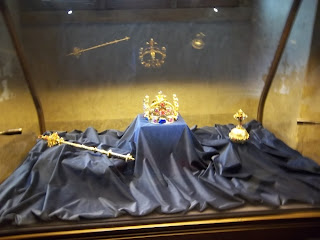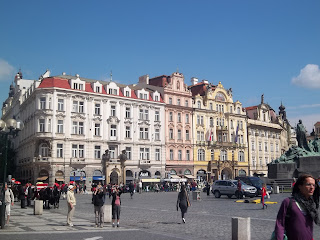We are in the south western part of the Czech Republic, not far from the border with Austria. The reason for our visit is to visit the town of Cesky Krumlov.
It is also very wet, and cold. As I write this I am sitting with a rug over my knees. The heater is also on. And summer starts tomorrow but we can see by the forecast that the weather is not going to improve too much. However, we have decided to forget about the rain, dress accordingly and enjoy the beautiful scenery. So today I set forth, in a fleece jacket, rain jacket, waterproof trousers, and an oversized umbrella. Consequently I was no longer cold or wet.
This photograph of the motor home was taken before we left the campsite, Camping Dolni Pocernice, in Prague, and at this stage we were concerned about getting bogged in the mud. But thankfully no. It had rained heavily all night, and the camping ground was a mess of mud and water. Most people left that morning, heading south in order to get some hot weather, I think.
And now we are in Camping Chvalsiny, another ACSI camping ground, run by people from the Netherlands. It is more like Camping Netherlands, as nearly all the campers are Dutch. The facilities, which are very new, are excellent, the showers even have under floor heating. It is set in farmland, close to the village of Chvalsiny.
A view of the campsite from the small lake. It stopped raining for a while this afternoon.
But back to the reason why we are here, and that is to visit Cesky Krumlov, which is 11 kms from the campsite. The castle is situated on a hill above the bend of the river Vltava, with the town spread out beneath it, on both sides of the river.I will first focus on the castle. A long story, and I apologise, as I know the names mean nothing to people, but I am determined to get the families sorted out. For my sake, anyway.
There was a Gothic stronghold here in the 13th Century, but the Rosmberks were mainly responsible for the stronghold taking on the appearance of a castle. For a brief time the castle was managed by the Habsburg family. Then it was taken over by the Eggenbergs in 1622 and in 100 years they managed to transform the castle into a magnificent renaissance chateau. After the Eggenbergs died out by 1719, Cesky Krumlov's destiny was in the hands of the Schwarzenbergs. They completed more renovations, including the Baroque theatre and the summer house in the gardens. The final owner was Dr Adolf Schwarzenberg, who had to leave it during WWII, and flee to the USA. In 1947 he tried to contest his rights to the ownership of the castle, but was defeated and the castle was taken over by the state. Phew!
We walked through the main gate and looked up and there was a most magnificent building. We went on a guided tour of the main castle and saw the most beautiful rooms, but unfortunately we were not allowed to take photographs. The tour guide gave a very interesting talk though, and some of the historical facts started to fall into place, as she explained the paintings and decorations in the rooms. I was fascinated by all the huge brown bear rugs in the rooms. But no, they were not shot, but rather died, and then made into rugs. Bears were kept for centuries in the old moat, and there were three there today. So no falling into the moat!
We walked along the passageway under the windows above, and received a wonderful view of the town of Cesky Krumlov. The river below was a raging torrent, due to the heavy rain.
We looked down from the other side of the walkway and could see our motor home nestled among the trees. I have the camera on 'zoom' as the van was a long way below.
A view of the castle tower, and part of the castle. This part of the castle now houses a museum, which opened in January 2011, and was also very interesting as well.
One of the courtyards in the castle. The wall of the castle is plaster, which has a brick work pattern painted on, to give it a 3D brick effect. There were other buildings in the town that had received the same treatment. The art technique is called Tromp l'oeil which is designed to create an optical illusion.
All the rooms in the castle had large, and sometimes enormous, ceramic heaters, which were fed coal from steel hatches with metal doors, outside in the corridors. This meant the occupants of the rooms were not disturbed. What a big job. The heaters were all on today, but I guess they are gas or electrically heated now. I forgot to ask!The town below the castle, was built over various centuries, with Gothic, Baroque and Renaissance buildings, with narrow winding streets circling the town square.
We were too slow setting off from the carpark, and got mixed up in a tour group, which would have been okay normally, but it was raining heavily and there were umbrellas everywhere.
Walter looking very comfortable under his large umbrella. No photos of me though, in all my wet weather gear.
During the communist era many of the buildings looked like this, crumbling stone and plaster, and peeling paint. Now this is the only building left to be renovated. Much work has been done in the past 20 years.
A view along a narrow side street, with St Vitus Church towering above the buildings. The church was decidedly German inside, but when the church was built the borders were not so defined as they are now.
The Town Square, which is overlooked by the Gothic Town Hall. My photograph of the Town Hall was not good.
More buildings in the Town Square.
Another street in the town of Cesky Krumlov. I would like to point out that the buildings do not lean as much now. I am obviously developing a better eye for photographing them, or I am becoming used to holding an umbrella while using the camera.
Lunch today was pork with potato pancakes and sauerkraut for Walter, and deep fried Camembert cheese with boiled potatoes, washed down with beer (Walter) and wine (me). and a wonderful view of the flooded river. Perfect.
And finally home again, and a walk before the rain started again.
Off through the countryside to BRNO which is in the eastern corner of the Czech Republic. I think.





















































